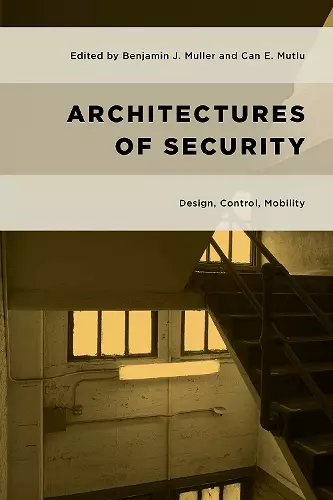Architectures of Security
Design, Control, Mobility
Benjamin J Muller editor Can E Mutlu editor
Format:Hardback
Publisher:Bloomsbury Publishing PLC
Published:18th Nov '24
Currently unavailable, and unfortunately no date known when it will be back

This book examines the relationship between architecture, security, and technology, focusing on the way these factors mutually constitute a “ferocious” architecture. This is an architecture, aesthetic and/or design that is violent, forcing the performances and practices of sovereign power and neoliberalism.
Architectures of Security: Design, Control, Mobility examines the relationship between architecture, security, and technology, focusing on the way these factors mutually constitute a “ferocious” architecture—an architecture, aesthetic, or design that is violent, forcing the performances and practices of sovereign power and neoliberalism. The text provides examples from urban spaces in both the global north and south, which discipline the mobility and movement of populations, as well as reinforce socioeconomic cleavages. From borders and borderlands, to airports, museums, and public buildings, the authors portray often inhumane examples of sovereign power.
Pushing the boundaries of critical geopolitics, architecture, design, and international politics, Muller and Mutlu's inventive and diverse collection brings a sharp and necessary focus on the border between aesthetics and control to understand how spaces, structures, and systems make the strange dangerous and the familiar seem safe. Architectures of Security is an important contribution to a series debates in critical international relations, critical security studies, human and cultural geography about infrastructure, affect, and control. -- Mark B. Salter, University of Ottawa
Architectures of Security is a much-needed examination of how violence unfolds through seemingly banal formations — in buildings, machines, atmospheres, and databases. It does the very difficult — but very necessary — work of exposing how the material world often enables exclusion, dispossession, and brutality. What really makes Architectures of Security stand out is the scope of its analysis: it traces the pernicious reach of materialised security in explicit sites such as airports and borders, but also shows its less obvious manifestations in places like schools, dementia wards, and museums. This book is an important articulation of these connections and starts a number of significant conversations about the unexpected fusions between architecture and security. -- Debbie Lisle, Queen’s University Belfast
Security. Violence. Exclusion. Oppression. Trauma. Death. How are these phenomena designed into the architecture of every aspect of our lives today? Architectures of Security answers this question through an exceptional boundary-pushing multidisciplinary foray into how security is materially, aesthetically, and technically built-in to the world. In doing so, it not only guides us to a profound novel understanding of the status quo of security politics, but equally opens crucial new avenues for understanding the future of that politics. -- Jonathan Luke Austin, The University of Copenhagen
ISBN: 9781786612229
Dimensions: unknown
Weight: unknown
182 pages